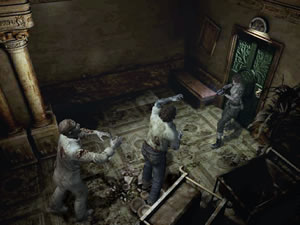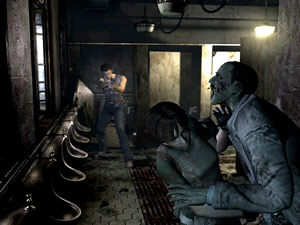Twice the characters, half the brains.
Capcom’s slick Resident Evil propaganda series has been largely successful
in its pro-zombie endeavors. It has managed to recruit legions of disgruntled
deceased and to cause subliminally receptive living people to question things
that are better left unanswered and generally feel creepy and insecure.
Having paused only briefly since their May 2002 assault on the gaming public,
the zombie hordes have returned to the GameCube in Resident Evil: Zero,
the prequel to the entire pro-zombie RE whitewash campaign. Although
not as polished as RE‘s debut on the GameCube,
RE: Zero is no slouch. It is still sharper, more horrific and certainly
better looking than the average wannabe-Survival Horror crapola.
Those
susceptible to zombie ideology may find RE: Zero particularly demoralizing,
as the game seeks to accentuate the frailties of mortals by putting forward
the message that it takes more than one of us to make interesting or at least
adequate sport for the undead. Case in point: in this latest venture you must
play as two – not one, but two – fairly sorry individuals. This gimmick is reminiscent
of RE clones such as Dino
Crisis 2 and generally don’t seem worthy of the genuine article.
You may remember Rebecca Chambers from the original RE. She was the
hapless, whiny-voiced “pianist” who had somehow managed to join S.T.A.R.S. despite
the fact that an underweight preteen could break her across their knee like
a dry stick. Well, she’s back again and unavoidable. You will also play as Billy
Cohen, a guy who is wanted for multiple murders and has a tragic taste in tribal
tattoos.
Unlike Resident Evil 2 for the
Playstation where you played as Claire and Leon on two separate disks, here
you can switch back and forth between Rebecca and Billy at will, basically from
the game’s beginning. They can act cooperatively or you can leave one behind
for a time and collect him or her later. Of course, neither of these characters
is capable of completing the game on their own. She can combine chemicals; he
can’t. He can push heavy stuff; she can’t. And if either of them dies it’s Game
Over, no matter how healthy and alert the other character might have been.
This removes quite a bit of the suspense from the game, as you find yourself suddenly charged with not only keeping a second character alive, but healing, equipping, and arming them as well. What should be a tension-charged, by-any-means-necessary survival marathon pales to an ongoing series of item-carrying negotiations.
To assure that your characters have plenty of opportunities to consult one
another on the issue of item storage, you can now leave any item anywhere. Players
of previous versions of RE games can, I’m certain, see the advantage
in this. No longer do you have to run all the way across a mansion to drop an
item in a save box so you can pick up something else. Now you can drop anything
on the fly and rearrange your items just about anywhere in the game.
In fact, there are no save boxes in the game, no nebulously defined territory of the Twilight Zone in which your belongings can nestle together for safety. No, instead they remain scattered exactly where you leave them: all over the place. Although they are kind enough to employ maps to remind you where you left everything, it merely ensures that you will spend most of the game running around looking for stuff you’ve already found. Of course, you can select a single room for deposit – but don’t be surprised when they start telling you the room is ‘full’.
To contribute to the focus on items, expect to discover more objects which will need to be examined or combined with other items. Also in abundance are items which demand two of your precious six inventory slots. Now, as before, a key will take up as much room as a handgun. Just about any gun worth using takes up two slots – and that’s not including the ammo. The stinginess of the slot distribution alone guarantees that you will be forced to leave items scattered about, no matter how orderly your intentions.
As in nearly all of the RE games, the graphics are top-notch. Although
RE: Zero doesn’t share the overall jaw-dropping appeal and slickness
of the GameCube version of the original RE, it still sports a stunning
level of detail. Water effects are nigh-on perfect and they’ve added a bit of
motion to backgrounds, which have historically remained static. These elements
combine to create a vivid and mesmerizing slice of a world plundered by rotting
miscreants. It should serve as a stern warning to any who would pooh-pooh the
awesome force of dead people gone bad.
 Although
Although
the non-interactive backgrounds look spectacular, we regrettably return to such
foibles as the cinema of your character’s feet ascending or descending a staircase,
although this had been done away with in the last game.
Control is your basic RE fare. You have your choice of analog or D-pad,
but both have their problems and both will have you caught on various corners
and pieces of scenery when your plan was probably more along the lines of some
rather agile running away. You still cannot do anything as revolutionary as
jumping or shooting a gun while you’re moving or – God forbid – shooting the
lock off of a wooden door. In fact, you are confined to about the same level
of mobility as that of an old lady with cataracts and a severe case of gout
– but that’s nothing new to the RE series. Think of it as a sort of handicap
imposed on those of us unhampered by rigor mortis and the general discomfort
of decomposition. This is the kind of ploy one expects to find in a heavily
zombie-influenced production.
The static camera angles are another clever ruse which allow the undead (and
the roving bands of mutated vandals with whom they associate) a spark of initiative
which could lead to full access to your medulla oblongata if you are not wary.
While the cinematic angles have an eerie beauty, when I enter a dark hallway
in zombie country I would rather see where I’m going – or at least what may
be seeing me.
Things are not quite what they may seem at first glance, anyway. That guy
standing in the corner over there…is he human? A zombie? Or a slimy, morphing
pile of mutant leeches which ooze potentially fatal pus and will smack the bejeezus
out of you with a tentacle that used to be the head of a guy named Marcus? Such
questions will become necessary to ponder as you prowl the atmospheric corridors
of this invitation to evil.
RE: Zero is replete with a host of new mutant creations. While some
of them are strictly refugees from a 1960’s grade-B Japanese monster flick,
others are definitely creepy new incarnations of nastiness. The denizens that
populate the dank halls, darkened rooms, and shadowy corridors of this game
are without a doubt some of the freakiest mutants yet seen in the series. Some
are familiar faces – Dogs, Hunters, and the omnipresent Zombies – but others
are new, imposing and very ugly.
The Resident Evil anti-living propaganda campaign loses just a little
steam with Resident Evil: Zero. It’s not quite as pretty as GameCube’s
RE, is flawed by the two-character gimmick and still features a screwy
inventory system. Nonetheless, it’s successful as both an entertaining, involving
Survival Horror game and a formidable tool of conscription for any dead person
with a chip on their shoulder.

-
More
-
Very good graphics
-
Really freaky creatures
-
Zombies!
-
Dropping items on the fly
-
Finding items dropped on the fly
-
Two-character gimmick
-
Lacking suspense
-
Dumb inventory system








